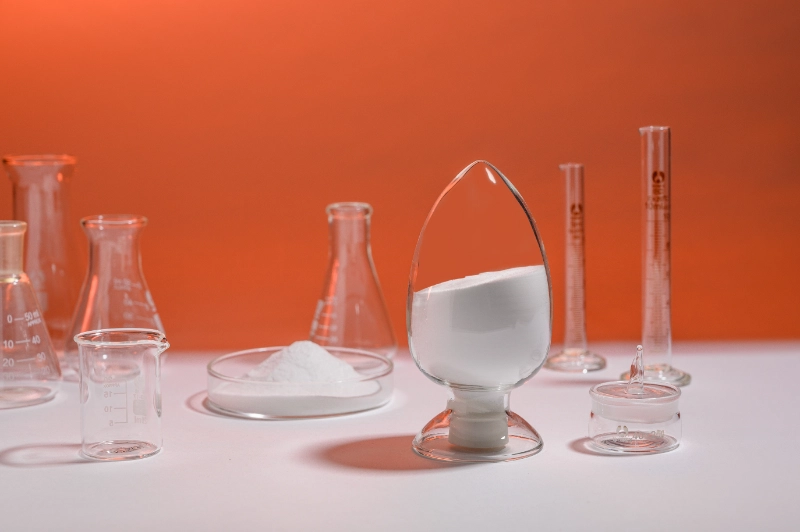Arachidonic acid (ARA), a polyunsaturated omega-6 fatty acid, is traditionally known for its role in the biosynthesis of pro-inflammatory eicosanoids such as prostaglandins and leukotrienes. In this blog post, CASOV, a high purity active cosmetic ingredients exporter, shares the protective benefits of antioxidant arachidonic acid for skin, and its potential as an antioxidant, capable of protecting skin tissue from damage caused by oxidative stress.
Arachidonic acid is a critical component of membrane phospholipids, particularly phosphatidylcholine and phosphatidylethanolamine. Upon cellular activation or injury, phospholipase A2 (PLA2) hydrolyzes these phospholipids, releasing free ARA into the cytosol. In the skin, ARA is present in keratinocytes, fibroblasts, sebocytes, and immune cells such as Langerhans cells. It plays essential roles in homeostasis, cellular signaling, and inflammatory regulation.
The skin, being the outermost barrier of the human body, is continually exposed to environmental stressors such as ultraviolet (UV) radiation, pollution, and pathogens. These insults generate reactive oxygen species (ROS), leading to oxidative stress, which in turn causes lipid peroxidation, DNA damage, and premature aging. The skin' s defense against such damage involves an intricate antioxidant system, in which lipid mediators, including arachidonic acid and its metabolites, are increasingly recognized for their potential protective effects.

Oxidative stress arises when there is an imbalance between the production of ROS and the skin' s antioxidant defense mechanisms. Key ROS include superoxide anion (O₂⁻), hydrogen peroxide (H₂O₂), hydroxyl radicals (•OH), and singlet oxygen (¹O₂). These species can damage cellular lipids, proteins, and nucleic acids, initiating inflammatory cascades and apoptosis. In the context of the skin, UV radiation is a major ROS inducer, particularly through UVA-induced generation of singlet oxygen and other free radicals within deeper dermal layers.
Chronic exposure to oxidative stress contributes to photoaging, characterized by collagen degradation, elastin fiber disorganization, epidermal thinning, and pigmentation disorders. Moreover, oxidative damage has been implicated in various dermatoses such as atopic dermatitis, psoriasis, and skin cancer. Therefore, augmenting the skin' s antioxidant defenses is a promising strategy for maintaining cutaneous integrity and function.
Despite its historical association with inflammation, arachidonic acid demonstrates context-dependent antioxidant properties. Several mechanisms underlie its protective effects:
ARA itself is a target of lipid peroxidation, yet its catabolism may serve to limit oxidative chain reactions. Through enzymatic conversion by cyclooxygenase (COX), lipoxygenase (LOX), and cytochrome P450 epoxygenases, ARA is transformed into bioactive eicosanoids that can modulate the redox environment. Certain prostaglandins, particularly PGE2, exhibit cytoprotective effects in epithelial tissues by maintaining vascular tone, stimulating epidermal proliferation, and enhancing barrier function.
Additionally, ARA' s incorporation into membrane phospholipids enhances membrane fluidity and repair, indirectly protecting against oxidative disruption. The selective release and subsequent oxidation of ARA in membranes can serve as a sacrificial antioxidant mechanism, sparing more structurally critical membrane components from oxidative damage.
ARA and its metabolites can modulate intracellular antioxidant defenses through signaling pathways such as Nrf2 (nuclear factor erythroid 2–related factor 2). Activation of Nrf2 leads to the transcription of antioxidant response element (ARE)-dependent genes, including heme oxygenase-1 (HO-1), glutathione peroxidase (GPx), and superoxide dismutase (SOD). Eicosanoids derived from ARA, such as 15-deoxy-Δ12,14-prostaglandin J2 (15d-PGJ2), have been shown to activate Nrf2 and exert cytoprotective effects in skin cells.
Under oxidative stress, ARA can influence apoptosis via the mitochondrial pathway. It has been observed that physiological concentrations of ARA can prevent UV-induced apoptosis in keratinocytes by modulating Bcl-2 family protein expression and inhibiting caspase activation. This protective effect is believed to be mediated through ARA' s interaction with membrane receptors and modulation of intracellular calcium signaling.
Moreover, in wound healing models, ARA promotes fibroblast proliferation, keratinocyte migration, and angiogenesis—processes crucial for tissue regeneration and repair, which are often impaired under oxidative conditions.

Preclinical studies have demonstrated the antioxidant capacity of ARA in various skin models. For instance, in murine models exposed to UVB radiation, topical application of ARA or its metabolite PGE2 resulted in reduced oxidative damage markers such as malondialdehyde (MDA) and 8-hydroxy-2'-deoxyguanosine (8-OHdG). These findings support the role of ARA in neutralizing ROS and enhancing DNA repair mechanisms.
In vitro experiments using human dermal fibroblasts and keratinocytes have further elucidated ARA' s protective role. When subjected to oxidative insults, cells treated with ARA exhibited lower ROS levels, preserved mitochondrial membrane potential, and reduced apoptosis. These effects were abolished by inhibitors of COX and LOX, indicating the necessity of enzymatic metabolism for ARA' s protective function.
Clinically, although direct application of ARA is less common due to its instability and potential for pro-inflammatory conversion, formulations containing ARA derivatives or modulators of its metabolism have been explored. Certain dermatological products incorporate ARA analogs to restore skin barrier function and mitigate inflammation in conditions such as eczema and rosacea, with concurrent benefits in reducing oxidative damage.
The role of arachidonic acid in skin biology is more nuanced than previously appreciated. Beyond its established function in inflammation, ARA exhibits significant antioxidant and cytoprotective properties that contribute to skin homeostasis, repair, and defense against environmental stressors. Through modulation of lipid peroxidation, activation of redox-sensitive pathways, and support of cellular survival, ARA presents a promising, albeit complex, agent in dermatological science.
Privacy Statement
Platform information submission - privacy agreement
● Privacy Policy
We are committed to protecting the privacy, personal data and personal data (collectively referred to as "personal data") provided by you when using this website. Make us comply with the highest standards in terms of collection, use, storage and transmission of personal data (laws and regulations related to privacy of personal data) and consumer protection. To ensure that you have full confidence in the handling of personal data on this website, you must carefully read and understand the provisions of the privacy policy. This website (hereinafter referred to as "us") respects and protects the privacy of users. In particular, once you use this website, you will be deemed to accept, agree, promise and confirm this privacy agreement; You disclose your personal data to us voluntarily with the required consent; You will abide by any modification of this privacy policy; You agree that our relevant business personnel will contact you regarding the products and services you may be interested in (unless you have indicated that you do not want to receive such messages). With your consent, we will collect, manage and monitor the types of personal data collected
1. Scope of application
It is our unremitting pursuit to provide users with better, better and more personalized services. We also hope that the services we provide will be more convenient for your needs. This privacy policy applies to all information collection services provided by this website. You can visit this website and use the services provided by this website using this privacy policy
2. What information do we collect
In order to provide you with our various services, you need to provide personal data information, including personal data and anonymous data, including but not limited to: personal data (your name, gender, age, date of birth, telephone number, fax number, address or mailing address, e-mail address, etc.)
3. How to use the collected information
The purposes and purposes of collecting personal data and anonymous data are as follows: to provide you with our services through this website; When you use our website, you can identify and confirm your identity; Let you get the service for you when you use this website; The relevant business personnel of this website can contact you when necessary; Make it more convenient for you to use this website; The personal data and anonymous data provided by you to us will only be retained until the collection purpose has been achieved, unless they are retained due to applicable laws and regulations. The ownership of personal data and disclosure of all data collected on our website are owned by us and will not be leased or sold to any unrelated third party
4. How do we protect information
For the protection of personal data, we implement appropriate physical, electronic and management measures to protect and guarantee the safety of your personal data. We try our best to ensure that any personal data collected through this website is free from any nuisance of a third party unrelated to us. The security measures we take are not limited to: physical measures: the records with your personal data will be stored in a locked place Electronic measures: the computer data with your personal data will be stored in the computer system and storage media subject to strict login restrictions Management measures: only employees authorized by us can access your personal data, These employees need to comply with our internal rules on the confidentiality of personal data. If you are aware of any security loopholes on this website, please contact us in time so that we can take appropriate actions as soon as possible; Despite the implementation of the above security measures, we cannot guarantee the absolute security of data transmission on the Internet, so we cannot absolutely guarantee that the personal data and anonymous data you provide to us through this website are safe at all times. We will not be responsible for any unauthorized access to your personal data, and we will not be responsible for any losses and damages incurred or caused in this regard.
5. Juvenile Protection Law
The minor has provided personal data to this website without the approval or consent of any parent or guardian. Please contact the public telephone number and customer service telephone number on this website in time to ensure that the data are removed
6. Revision and effectiveness of privacy policy
With the expansion of the service scope of this website, we may revise the Legal Statement and Privacy Policy from time to time, which forms a part of this Legal Statement and Privacy Policy. In order to prevent you from being informed of such revisions, please read this Legal Statement and Privacy Policy frequently. In any way, if you continue to use our services, you agree to be bound by the revised Legal Statement and Privacy Policy